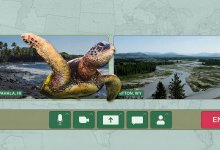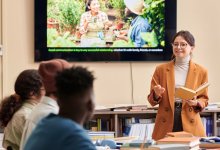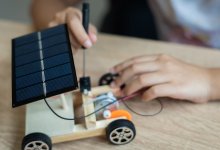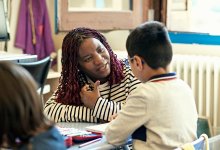- Administration & Leadership
Strengthening Students’ Foundational Math Skills in Middle School
If many students are struggling with operations like dividing decimals, this schoolwide approach to scheduling can help.Your content has been saved!
Go to My Saved Content. - Classroom Management
How to Create a Values-Aligned Classroom
Teachers can collaborate with students to identify shared values that establish a foundation of respect and a positive learning environment.Your content has been saved!
Go to My Saved Content. - Social & Emotional Learning (SEL)
Modeling Calm for Preschool Students
Teachers can focus on promoting a sense of emotional safety to help students develop self-regulation and resilience.Your content has been saved!
Go to My Saved Content. - Brain-Based Learning
5 Ways to Help Students Reset Their Thinking
When students hit cognitive roadblocks, these strategies will help them pause, rethink their approach, and reengage with their learning process.Your content has been saved!
Go to My Saved Content. - Formative Assessment
Using Interviews to Gain Insight Into Students’ Math Thinking
Elementary teachers can talk with students one-on-one to probe their thinking and learn things that might be missed with traditional assessments.365Your content has been saved!
Go to My Saved Content. - Student Engagement
Simple Swaps for Moving From Passive to Active Learning
These tips demonstrate that planning for active learning experiences doesn’t have to be time-intensive or difficult.329Your content has been saved!
Go to My Saved Content. - Technology Integration
A Virtual Collaboration Project Centered on American Democracy
In a program sponsored by the Smithsonian, students in two different parts of the country interact to explore a civics question that is meaningful to both groups.220Your content has been saved!
Go to My Saved Content. - Game-Based Learning
Using Choice Boxes to Enhance Student Engagement
Providing upper elementary students with choices can help teachers differentiate through learning experiences that feel fun. - Project-Based Learning (PBL)
Problem-Based Learning and Future-Ready Skills
Well-designed projects help students build valuable skills such as collaboration, critical thinking, and communication.1.1kYour content has been saved!
Go to My Saved Content. - Career & Technical Education
How High School Students Can Benefit From Using LinkedIn
It’s to students’ advantage to begin thinking about their future career plans, and the platform can help guide that planning.568Your content has been saved!
Go to My Saved Content.
Popular
- Research
The 10 Most Significant Education Studies of 2025
We’re back with our roundup of the most insightful studies of the year, from the power of brain breaks to groundbreaking research on AI, cell phones, and handwriting in the classroom. - Student Engagement
3 Ways to Prime Students’ Brains for Achievement
Using priming language is a powerful way to set the stage for learning, and we’ve got a free downloadable word bank here to help you implement this research-backed strategy. - Student Engagement
5 Ways to Encourage Deep Mathematical Thinking
You can adapt the curriculum you have to create rich tasks that invite reasoning and build students’ problem-solving skills.35.9kYour content has been saved!
Go to My Saved Content. - Technology Integration
3 Simple Slide Tips That Deepen Learning—and Save Time
Whether you use Google Slides or something else, you can promote deep thinking during presentations by tweaking the slides you already have.15.5kYour content has been saved!
Go to My Saved Content. - Media Literacy
5 Ways to Build Critical Literacy in the Age of AI
With so much information—and misinformation—coming at them every day, students need to learn how to verify truth.
- Social & Emotional Learning (SEL)
Strategies to Help Students Transition Into the Week
Teachers can intentionally plan their Mondays to create classrooms that students feel drawn back into, not pressured by.1.8kYour content has been saved!
Go to My Saved Content. - Administration & Leadership
Connecting School Values and Student Well-Being
Aligning your social and emotional learning curriculum with a clear set of values helps students see the relevance and importance of those lessons.1.4kYour content has been saved!
Go to My Saved Content. - Technology Integration
How to Create Effective 15-Minute SEL Activities
Teachers can use a variety of tech tools to create short social emotional learning activities that fit easily into the classroom routine.1.5kYour content has been saved!
Go to My Saved Content. - Social & Emotional Learning (SEL)
Using Mythology to Ground Social and Emotional Learning
Teachers can leverage students’ interest in Greek mythology to explore emotions and topics like overcoming obstacles.2.3kYour content has been saved!
Go to My Saved Content. - Collaborative Learning
Manager, Facilitator, Motivator, Advocate: Setting Up Group Roles That Really Work
Designating a meaningful role for each group member helps students reach their potential both individually and collectively.
- STEM
How STEM Projects Support Belonging in Middle School
When students engage in hands-on, collaborative problem-solving, they see themselves as essential to their classroom community.939Your content has been saved!
Go to My Saved Content. - Critical Thinking
9 Ways to Teach Spatial Thinking Across the Curriculum
Strong spatial skills are critical for everyday tasks and across many careers—they also strengthen students’ math performance.3kYour content has been saved!
Go to My Saved Content. - STEM
Connecting Science to Problem-Solving in the Real World
Tackling authentic problems in science class helps students see the link between the lab and the challenges facing our world—and builds multiple skills along the way.Your content has been saved!
Go to My Saved Content. - Critical Thinking
Fostering an Entrepreneurial Mindset in Middle School
Having students design their own brands, logos, and podcasts gives them the opportunity to develop problem-solving and creativity skills.2kYour content has been saved!
Go to My Saved Content. - STEM
Integrating STEM Across the Curriculum
Equipping students with transferrable skills such as innovative thinking and problem-solving can have a powerful effect on learning.2.1kYour content has been saved!
Go to My Saved Content.
- Mental Health
5 Strategies to Deescalate Behavior When Students Are Dysregulated
Students may lack the skills to control their behavior when they’re upset, and these steps can help build self-regulation.2kYour content has been saved!
Go to My Saved Content. - ChatGPT & Generative AI
Schools Try AI as Student Mental Health Needs Surge
Social and emotional, behavioral, and mental health needs are outpacing what schools can provide. Can technology—namely AI—step in to help?4.6kYour content has been saved!
Go to My Saved Content. - Mental Health
How to Cope With the Tragic Loss of a Student
Two school counselors share advice for educators on how to support students when a peer passes away.1.5kYour content has been saved!
Go to My Saved Content. - Mental Health
Recognizing and Addressing Emotional Overload to Better Support Students
Teachers may misinterpret behaviors as laziness when their students are actually working beyond their emotional limit.3.7kYour content has been saved!
Go to My Saved Content. - Student Wellness
3 Ways to Help Students Build Attention Stamina
These simple tools and strategies can improve focus in the classroom.





























